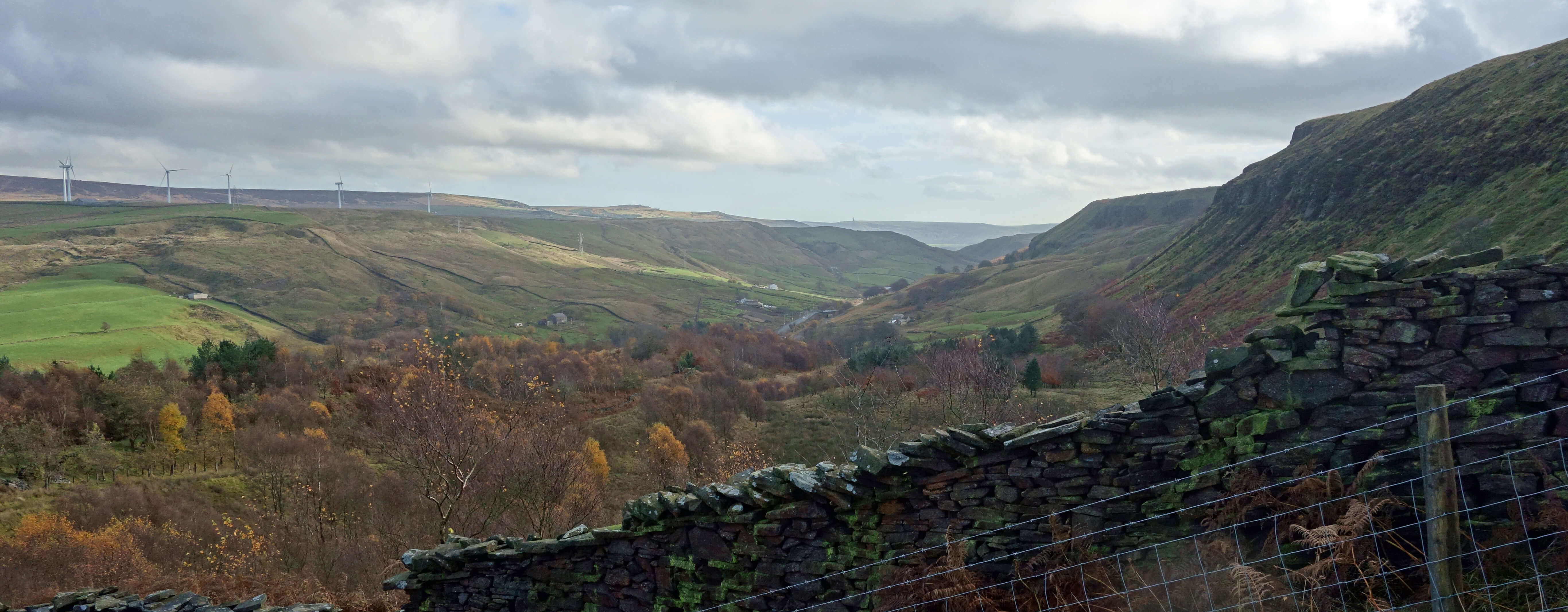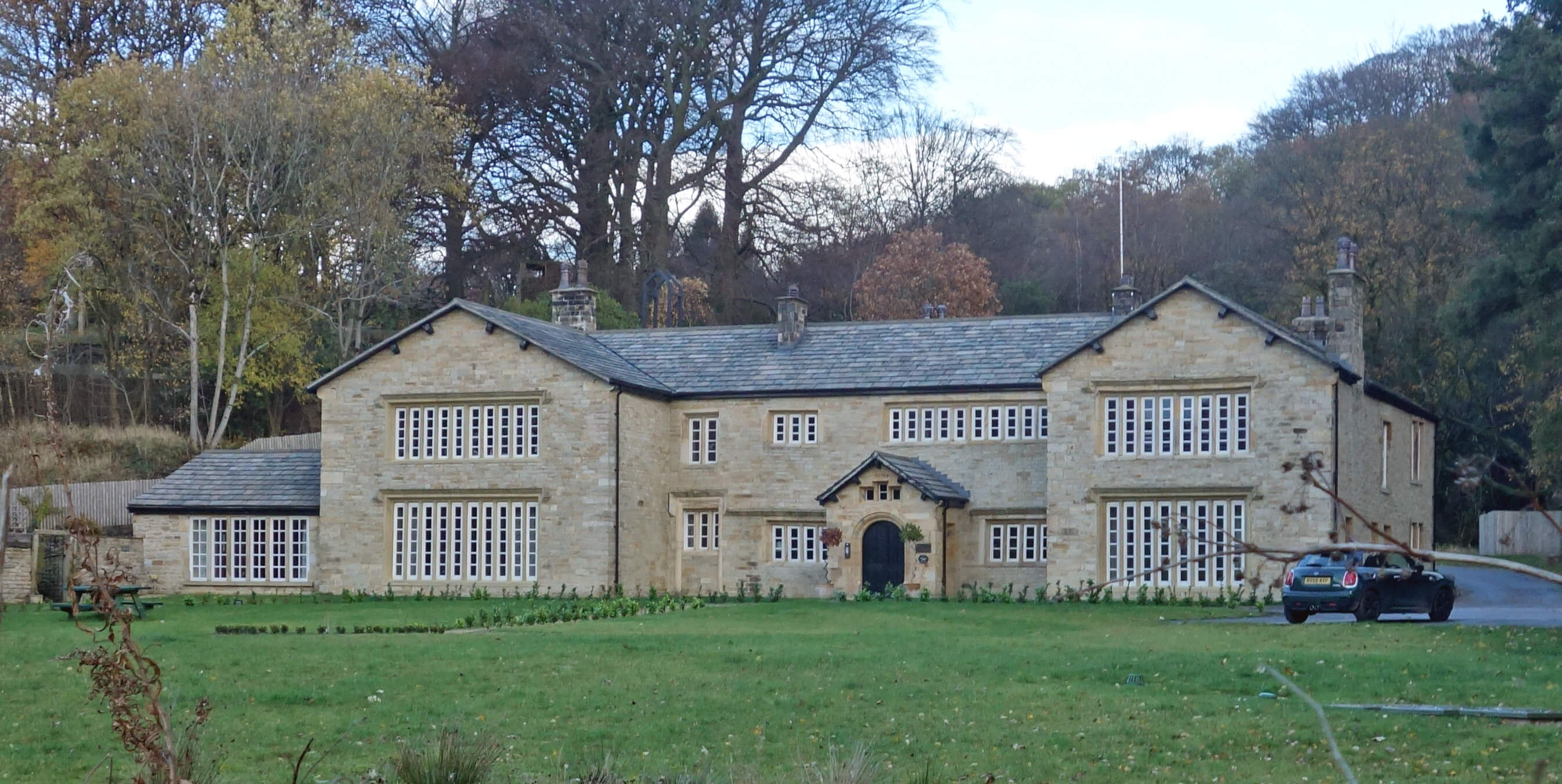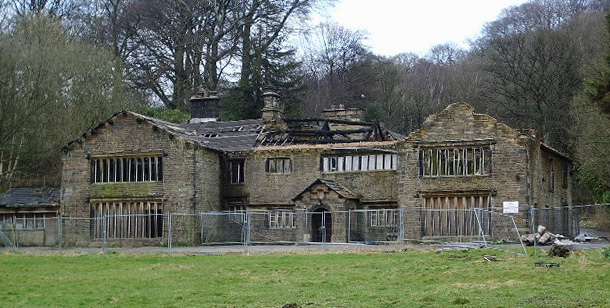
Home
Preamble
Index
Areas
Map
References
Me
Drakkar
Saunterings: Walking in North-West England
Saunterings is a set of reflections based upon walks around the counties of Cumbria, Lancashire and
North Yorkshire in North-West England
(as defined in the Preamble).
Here is a list of all Saunterings so far.
If you'd like to give a comment, correction or update (all are very welcome) or to
be notified by email when a new item is posted - please send an email to johnselfdrakkar@gmail.com.
34. Thieveley Pike and the Singing Ringing Tree
Thieveley Pike (449 metres) is the highest point of Deerplay Moor, five miles south-east of Burnley. The
climb to the top of the moor from the ambitiously-named Cliviger Gorge has a modicum of drama but
the top itself is unassuming. It is a smooth, boggy hump with just a trig point and a fence.
Still, the views are extensive: to Pendle beyond Burnley, to the West Pennine moors over Rossendale,
to the Bowland fells, and, on a clear day, to the Dales Three Peaks – not forgetting about sixty windmills.

Cliviger Gorge

From Thieveley Pike towards Burnley and Pendle
However, it seems that the region around Thieveley Pike is too dull for some. It has been enlivened by
various sculptures. I headed south past the source of the River Irwell, which flows through Manchester
to join the Mersey, to find the
Irwell Sculpture Trail
or the beginning of it at least because it is said to be England’s largest piece of public art, running for over thirty miles and including some seventy artworks. Unfortunately, I cannot report upon the artworks because I found no sign of or to the Trail where it is marked on the OS map, north of Weir. I understand that the Trail is a work in progress – perhaps it hasn’t yet progressed to the northernmost end of the Trail. Dark clouds were gathering, so I did not prolong my search.
I headed west on the Rossendale Way, aiming for the acclaimed Singing Ringing Tree.
But never mind the artworks – I became depressed by the prevailing scruffiness. OK, autumn
is an untidy time, with decay in the air and mud on the ground. This, however, does
not excuse the rubbish, rusty machinery, rubble, and so on that litters the footpaths
and roadsides. It’s as though the standards are set by the old dark stone walls.
The walls are all falling down: why bother to tidy up anything else? There are
no grants to keep these walls in order, as there are for walls in the Dales and Lakes, because their sombre appearance has no appeal for visitors.
After Sod Hey Farm I thought 'hey, sod it': I might as well walk directly along the road to Crown Point and the
Singing Ringing Tree. The Tree was designed by Mike Tonkin and Anna Liu in 2006 and a year later won a
Royal Institute of British Architects National Award. It is now the centrepiece of the
Wayside Arts Trail.
The Tree is one of four
Panopticons,
the others being near Blackburn, Haslingden and Wycoller. I tried
not to let the pretentious re-definition of ‘panopticon’ put me off. The word was first used to describe a prison where all inmates may be monitored and has recently been co-opted for modern surveillance techniques and in photography to describe a kind of panoramic image. The Lancashire structures are called panopticons because they provide a comprehensive view. Actually, the view from the Tree is not that comprehensive: you can’t see far to the south.

The Singing Ringing Tree
Contrary to what I said above, the Panopticons were not designed to enliven dull regions: they “were designed to attract visitors into the countryside to enjoy the stunning landscapes.”
Can a landscape dominated by a view of Burnley really be stunning? Aren’t visitors
attracted to stunning landscapes anyway? Perhaps the designers, knowing that they would be, wanted more visitors to chance upon their artwork. Perhaps it was hoped that fine artworks would encourage people to treat their countryside with more respect than I had seen on my walk here.
 In general, do we need sculptures in our countryside? This question
rather presumes that we do need sculptures but not necessarily in the countryside. The countryside, it may be thought, speaks for itself. The word ‘countryside’, coming from the Latin contra (or other), implies that the countryside is other than something, the city. What is suitable for one may not be for the other. If sculptures are thought to be intended for the built environment of cities then we might think that they do not belong in the natural countryside.
In general, do we need sculptures in our countryside? This question
rather presumes that we do need sculptures but not necessarily in the countryside. The countryside, it may be thought, speaks for itself. The word ‘countryside’, coming from the Latin contra (or other), implies that the countryside is other than something, the city. What is suitable for one may not be for the other. If sculptures are thought to be intended for the built environment of cities then we might think that they do not belong in the natural countryside.
I am not referring to structures such as cairns which may be more ornamental than their function
demands but to works constructed by an artist to be viewed in a countryside setting that have no function
other than to have an aesthetic impact upon the viewer. For example, Andy Goldsworthy created a series of
artworks based upon old
Cumbrian sheepfolds
– there is one in Tilberthwaite, another near Cautley Spout, and so on. These works are intended to
meld into their surroundings so that a viewer may not even be sure whether they are artworks or not.
Most of these creations are ‘land art’, that is, they are created from natural materials. In many cases,
land art is intended to be ephemeral and to disappear into its surroundings in due course. Some artworks
don’t require materials at all. For example, Richard Long created
A Line Made by Walking in 1967 by
walking up and down a field, a work considered a formative piece by the Tate Gallery in a 2007 exhibition. (Ah, perhaps we shouldn’t consider our worn hillside tracks as disfigurements but as works of art.)
These, however, are different from the explicitly artistic sculptures that are set prominently in
the landscape, such as the Water Cut in Mallerstang, installed in 1998 as one of a series of
Eden Benchmarks
and indeed the Singing Ringing Tree. I cannot think of anything similar on the Lake District fells
although there are sculptures rather tucked away in Grizedale Forest, between Esthwaite Water and
Coniston Water. I can’t picture a Singing Ringing Tree ever being installed on Helvellyn.
Anyway, I appreciated the Singing Ringing Tree as an imaginative reflection on the nature
of its location. The main natural element of this exposed setting is the wind, which the sculpture
certainly captures. As the name indicates, it is a structure to be heard as well as seen,
although the noise of the wind in the pipes was, to me, interesting rather than attractive.
Overall, is the Singing Ringing Tree more artistic than the windblown hawthorn tree that might
otherwise have occupied this spot?


Approaching my parking spot I passed this distinctive building
(shown left). The map calls it The Holme, using its font marking an ancient building.
The original The Holme was built in the 15th century. After passing through various hands and
serving various functions, it fell into ruin (shown right, as it was in 2008).
It has since been faithfully restored and is, I think, now called Holme Hall
or Holme Hall Manor.
Date: November 12th 2018
Start: SD880279, lay-by SE of Holme Chapel (Map: OL21)
Route: NW, S over railway line, W – Dean Scout – S – Thieveley Pike – SE on Burnley Way, S, W –
A671 – W – Height End, Clifton – N – A671 – NW on A671, Crown Point Road – Crown Point – E –
Singing Ringing Tree – E – Burnley Way, near Dyneley Farm – SE, N, SE – Holme Chapel, lay-by
Distance: 8 miles; Ascent: 270 metres
Home
Preamble
Index
Areas
Map
References
Me
Drakkar
© John Self, Drakkar Press, 2018-

Top photo: The western Howgills from Dillicar;
Bottom photo: Blencathra from Great Mell Fell





 In general, do we need sculptures in our countryside? This question
rather presumes that we do need sculptures but not necessarily in the countryside. The countryside, it may be thought, speaks for itself. The word ‘countryside’, coming from the Latin contra (or other), implies that the countryside is other than something, the city. What is suitable for one may not be for the other. If sculptures are thought to be intended for the built environment of cities then we might think that they do not belong in the natural countryside.
In general, do we need sculptures in our countryside? This question
rather presumes that we do need sculptures but not necessarily in the countryside. The countryside, it may be thought, speaks for itself. The word ‘countryside’, coming from the Latin contra (or other), implies that the countryside is other than something, the city. What is suitable for one may not be for the other. If sculptures are thought to be intended for the built environment of cities then we might think that they do not belong in the natural countryside.


